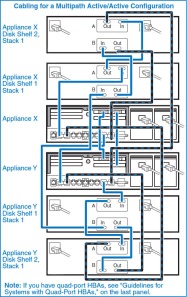Cabling for active/active NetApp cluster is defined in Active/Active Configuration Guide. It’s described in detail but may be rather confusing for beginners.
First of all we use old DATA ONTAP 7.2.3. Much has changed since it’s release, particularly in disk shelves design. If documentation says:
If your disk shelf modules have terminate switches, set the terminate switches to Off on all but the last disk shelf in loop 1, and set the terminate switch on the last disk shelf to On.You can be pretty much confident that you won’t have any “terminate switches”. Just skip this step.
To configuration types. We have two NetApp Filers and four disk shelves – two FC and two SATA. You can connect them in several ways.
First way is making two stacks (formely loops) each will be built from shelves of the same type. Each filer will own its stack. This configuration also allows you to implement multipathing. Lets take a look at picture from NetApp flyer:

Solid blue lines show primary connection. Appliance X (AX) 0a port is connected to Appliance X Disk Shelf 1 (AXDS1) A-In port, AXDS1 A-Out port is connected to AXDS2 A-In port. This comprises first stack. Then AY 0c port is connected to AYDS1 A-In port, AYDS1 A-Out port is connected to AYDS2 A-In port. This comprises second stack. If you leave it this way you will have to fully separate stacks.
If you want to implement active/active cluster you should do the same for B channels. As you can see in the picture AX 0c port is connected to AYDS1 B-In port, AYDS1 B-Out port is connected to AYDS2 B-In port. Then AY 0a port is connected to AXDS1 B-In port, AXDS1 B-Out port is connected to AXDS2 B-In port. Now both filers are connected to both stacks and in case of one filer failure the other can takeover.
Now we have four additional free ports: A-Out and B-Out in AXDS2 and AYDS2. You can use these ports for multipathing. Connect AX 0d to AXDS2 B-Out, AYe0d to AXDS2 A-Out, AX 0b to AYDS2 A-Out and AY 0b to AXDS2 B-Out. Now if disk shelf module, connection, or host bus adapter fails there is also a redundant path.
Second way which we implemented assumes that each filer owns one FC and one SATA disk shelf. It requires four loops instead of two, because FC and SATA shelves can’t be mixed in one loop. The shortcoming of such configuration is inability to implement multipathing, because each Filer has only four ports and each of it will be used for its own loop.
This time cabling is simpler. AX 0a is connected to AXDS1 A-In, AX 0b is connected to AYDS1 A-In, AY 0a is connected to AXDS2 A-In, AY 0b is connected to AYDS2 A-In. And to implement clustering you need to connect AX 0c to AXDS2 B-In, AX 0d to AYDS2 B-In, AYe0c to AXDS1 B-In and AY 0d to AYDS1 B-In.
Also I need to mention hardware and software disk ownership. In older system ownership was defined by cable connections. Filer which had connection to shelf A-In port owned all disks in this shelf or stack if there were other shelves daisy chained to channel A. Our FAS3020 for instance already supports software ownership where you can assign any disk to any filer in cluster. It means that it doesn’t matter now which port you use for connection – A-In or B-In. You can reassign disks during configuration.
No comments:
Post a Comment